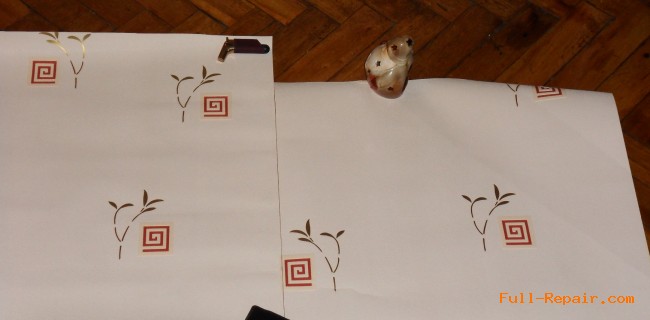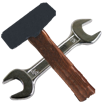By the choice of wallpaper should be approached very carefully, as they will set the tone and overall style of your room. Also keep in mind when choosing the type and condition of the room walls.
Dry environment you can use any types of wallpaper, for wet room (bathroom, toilet, kitchen) - embossed or plain vinyl wallpaper (washable) for uneven walls better glue embossed wallpaper or wallpaper with large cells or with a dense pattern.
Choose a high quality wallpapers! If you choose wallpaper with a pattern, then you will need more time and skill to carry out his plan. The main difficulty is to figure coincide, and therefore part of the wallpaper to be clipped ( keep this in mind, the expense could increase significantly wallpaper ). With the self-colored wallpaper is much less fuss.
What tools do you need to prepare for: capacity where you will grow glue (bucket), clean water with a sponge to clean the walls and remove excess adhesive, ladder, line cutting wallpaper and pencil, cloth, cushion for joints, trowel, brush glue ( What will you apply the adhesive), scissors. And, of course, prepare yourself job, so you do not hurt too much and had a lot of places where you will lay out wallpaper.

What Glue Choose?
When choosing the adhesive is important to consider the form of wallpaper. Paper wallpaper and borders purpose adhesive suitable for vinyl (washable) and heavy, embossed wallpaper there are special adhesives. For non-woven wallpaper should also pick up a special glue.
So, Start Working!
The first thing to do - is to prepare the wall. To do this, get rid of old wallpaper and trim the wall, not to leave the old glue and paper. To remove old wallpaper, you can use a special solution, which is diluted in warm water and applied to the wall (to wait for 10 minutes), then to easily and naturally you can with a spatula to clean the wall. If you painted a wall, for its preparation is recommended to wash the wall with a special detergent and then rinse it with hot water. You can also use a special steam cleaner.
After cleaning, check the condition of your walls. If there are any irregularities can try to align them with the help of special mixtures or with drywall. If there are holes and cracks, they can be ground, and then align the surface finishing putty. Painted wall should be treated with a coarse sandpaper to remove flaking paint. If you have damp walls, then treat them with a special primer for damp walls. Follow the instructions. Remember that the wall surface is completely dry and clean. Let the walls dry thoroughly, and only then proceed with pasting.
Prepare Wallpaper
Now there is a wide variety of wallpaper, which is necessary to select a picture for a full picture. If you do something wrong, then we can design and spoil surpluses wallpaper cut.
Prepare the front page: measure the height of the wall, not including the height of the plinth. On a roll, measure the required distance and add 5-10 cm at trimming the edges, draw a line and cut it using scissors. If you get a roll of 4 page, then you can not leave the tolerance is not terrible, skirting hide the missing piece. If the pattern does not require alignment of wallpaper, cut several strips, applying them to the front page for accurate measuring. The direction of the drawing.
Turn the wallpaper on the back side and mark where it will be over, and where the bottom. Next, you need to mark the position of the wall wallpaper. Measure of the distance from the window equal to the width roll minus 3-4 cm Spend exact vertical line - this will be a landmark for the label of the first band.
Prepare Glue
For information on how to prepare the adhesive, see the instructions. Proportions to obtain the desired consistency. Allow adhesive 10 minutes before using. It is not recommended to plant at the same time, several packs of glue, as it can take crumbs.
start Wallpapering
With a brush, apply glue to half of the strip, dividing it from the center to the edges. Edge coated with particularly well. Fold in half glued to the back side without holding place the fold. Likewise seal the second lane and leave the glue to impregnation (5-10 minutes). Paper wallpaper soaking time - 5 minutes for thick wallpaper - 7-10 minutes for vinyl - 8-10 minutes.
That does not appear bubbles and wrinkles wallpaper should stick with windows and doors closed, and the next day also avoid drafts and artificial land, which can lead to peeling and other negative effects.
Apply the wallpaper, from the window. Place the top of the wallpaper to the wall, leaving the bottom half of the folded. Align the strip drawn by on line, leaving the top margin of 3-5 cm Clutching wallpaper to the wall straighten the strip from the center to the edges of the brush, squeezing out the air. Keep a dry cloth to remove any excess glue. Then expand the second half of the band, holding the upper part, so that it slipped. Flatten evenly. If there are still bubbles pierce them with a pin and carefully smooth out again.
Move to the next lane. Smear multiple bands is not recommended. Every time align the edge on the previous strip. Ensure synergies edges. In the case of error, you can peel the last strip and-stick its edge with the edge of the previous one.
The joints between the strips go roller to make them less noticeable. When working with embossed wallpaper is better to pass joints cloth, being careful not to push the figure.
Edge trimming wallpaper at the ceiling when the wait for the glue to dry. Cut with a sharp knife, using a spatula as a constraint.
If you paste over the corners, it is necessary to measure the distance from the last strip to the corner. Add to that a couple of inches and cut off a strip of width obtained. First attach much wallpaper, then perform blunt the wallpaper in the corner (very carefully so as not to tear it) and a good smooth narrow strip on the new wall.
In order to paste over the wall behind the radiator (in case if it is not removed), cut the wallpaper in places supply pipes and radiator mounting. For leveling the wallpaper, you can use a mop with a plastic PVC pipe to it or with cardboard, wrapped in a clean cloth. Smooth out the wallpaper, a mop sink down so that they are firmly stuck to the wall. Finally, wipe the traces of glue on the wallpaper and the heat sink.
In the same spirit, continue pasting the walls to the end.
By following these instructions you always succeed. Do everything carefully and take your time. Good luck!
 Full-Repair.com
Full-Repair.com